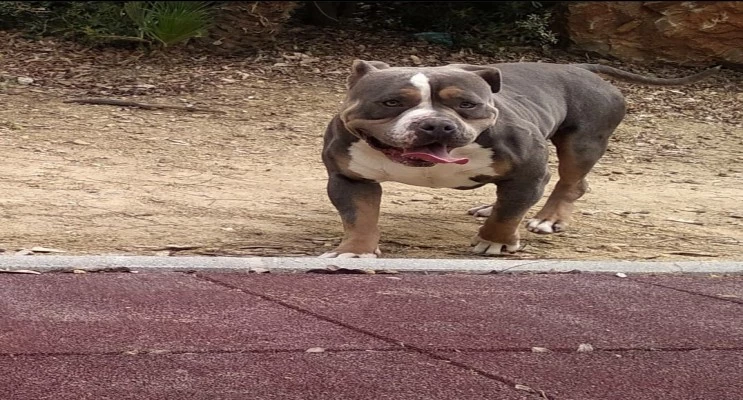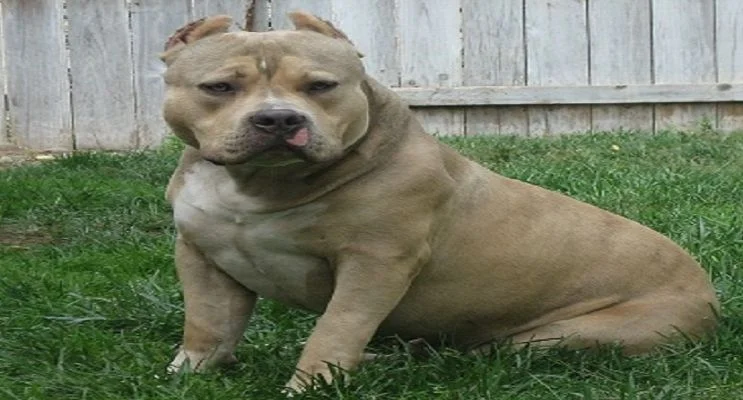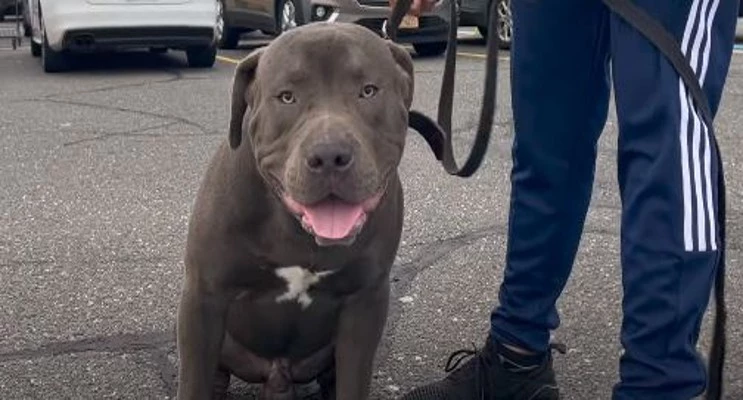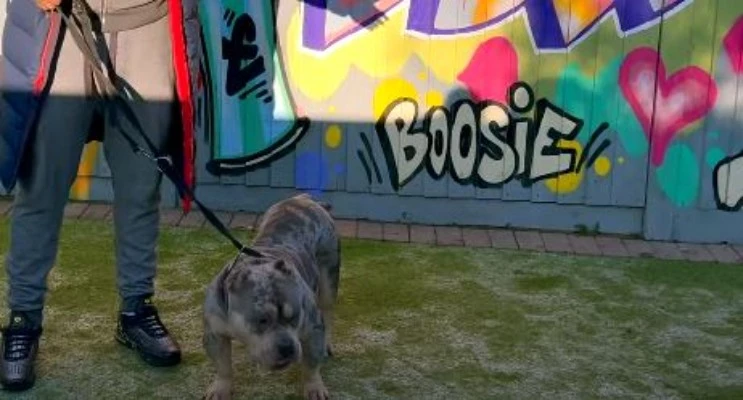Are you curious about the Tricolor American Bully breed? If so, you’re in the right place. This guide will provide you with all the information you need to know about this unique breed, from its stunning coat colors to its temperament and everything in between.
You’ll learn about the importance of the tan point gene and Agouti gene series locus in its coat color and how to plan a responsible breeding program. Plus, you’ll discover the cost of obtaining a Tri Color Bully puppy and how they differ from other Bullies.
So, if you want to learn about this breed and find out if it’s the right fit for you, keep reading!
Contents
- What is a Tricolor American Bully?
- What causes American bullies To Have Tricolor?
- What Is the Origin of the Tricolor Gene in the American Bully?
- Are Tricolor American Bullies Rare?
- Tricolour American Bully: Temperament
- Are Tri-Color Bullies Different From Other Bullies?
- Types of Tricolor Bully
- Chocolate Tri Bully:
- Chocolate Tri Merle Bully:
- Black Tri Bully:
- Black Tri Merle Bully:
- Blue Tri Bully:
- Blue Fawn Tri Bully:
- Fawn Tri Bully:
- Lilac Tri Bully:
- Lilac Tri Merle Bully:
- Ghost Lilac Tri Bully:
- Ghost Tri Bully:
- Black Ghost Tri Bully:
- Blue Ghost Tri Bully:
- Champagne Ghost Tri Bully:
- Ghost Lilac Tri Bully:
- Tri Merle Bully:
- Purple Tri Bully:
- Tri Brindle or Trindle Bully:
- Piebald Tri Bully:
- Reverse Tri Color Bully:
- Sable Tri Bully:
- Ticked Tri Bully:
- White Tri Bully:
- Are Tricolor American Bullies More Prone To Health Issues?
- What is the Cost of Tricolor American bully?
- Tips on Breeding Tricolor American Bully?
- Final Thoughts
What is a Tricolor American Bully?
A Tricolor American Bully is a specific variation of the American Bully breed. Tricolor is a coat color pattern that consists of three distinct colors: usually a combination of white, black, and tan.
In the case of a Tricolor American Bully, the dog’s coat will typically display a combination of these three colors. The distribution and intensity of each color can vary, with some dogs having more prominent black markings while others may have more tan or white. The specific patterns and markings can differ from one dog to another, resulting in unique and eye-catching appearances.
When considering any breed, including the American Bully, it is essential to focus on responsible breeding practices, temperament, and overall health rather than solely on coat color or pattern.
What causes American bullies To Have Tricolor?
Understanding the genetics behind the tricolor coat pattern can help you make the most informed decision when looking for a Tri-Color American Bully puppy.
The tricolor coat pattern is caused by the interaction of several different genes that control pigmentation in the skin and coat. The recessive Tan Point gene must be present in both parents to create Tri Color Bullies, and this gene is responsible for the tan points on the eyebrows, cheeks, legs, and chest.
The Agouti gene series locus also plays a role in the tricolor coat pattern and regulates the interaction of the two pigments in the dog coat. American Bullies contain red and black pigments, and this gene is responsible for the different coat colors and patterns, such as chocolate, black, and merle, or black and white with a “marbled” or mottled pattern produced by the merle gene.
What Is the Origin of the Tricolor Gene in the American Bully?
One may wonder about the origin of the gene responsible for the unique and striking tricolor coat pattern in the American Bully breed. The answer lies in the breed’s history and genetic makeup.
The American Bully, like many other dog breeds, has its roots in various breeds, including the American Pit Bull Terrier, American Staffordshire Terrier, Bulldog, and Mastiff. These breeds all have the tan point gene, which is responsible for the tricolor coat pattern.
The tan point gene has been present in the American Bully breed since its inception, but it wasn’t initially considered desirable. However, some breeders began selecting the gene to produce tricolored dogs.
Two dogs that are not tricolored can produce tricolored puppies if both are carriers of the tan point gene. This means that the gene has been passed down through generations of American Bullies, making it a common trait in the breed.
In conclusion, the tricolor gene in the American Bully breed comes from the tan point gene that is present in several of the breed’s ancestor breeds. While not initially considered desirable, some breeders began selecting for the gene to produce the striking tricolor coat pattern that is now commonly seen in the breed. The gene has been passed down through generations of American Bullies and is a defining characteristic of the breed.
Are Tricolor American Bullies Rare?
Tricolor American Bullies are considered relatively rare compared to other coat color variations within the breed. The tricolor pattern involves three distinct colors, often including white as a base color along with patches or markings of two other colors, such as black, brown, or tan. The rarity of tricolor American Bullies can be attributed to several factors:
Genetic Variation:
The tricolor pattern in American Bullies is created by specific combinations of genes that determine coat color and markings. To produce the tricolor pattern, multiple alleles (different forms of genes) are needed, which contribute to the various colors. However, these alleles may be less common in the American Bully gene pool compared to other coat color alleles. As a result, tricolor individuals are less frequently found in the breed.
Selective Breeding:
Breeders who specifically focus on producing tricolor American Bullies may intentionally limit their breeding programs to dogs with tricolor genetics. This selective breeding approach, coupled with the relative rarity of tricolor alleles, can contribute to a smaller population of tricolor American Bullies compared to more common coat color variations.
Popularity and Demand:
As more and more people find the tricolor pattern of American Bullies attractive, the demand for them has grown over time. However, due to the limited number of tricolor individuals available, finding them can be relatively more difficult compared to other coat color variations. This combination of high demand and limited availability adds to the perception that tricolor American Bullies are rare.
Tricolour American Bully: Temperament
The tricolor American Bully is similar to other American Bullies in terms of temperament. The only difference is the color of their coat. Whether it’s a tricolor American Bully or any other type, they tend to have the same temperament: calm, confident, and friendly.
These dogs are generally well-natured, eager to please, and enjoy being around people. They are known for their strong bond with humans and are often considered great family pets.
American Bullies are typically known for being stable and calm. They can be patient and tolerant, especially with children.
However, individual temperaments can still vary. Some may be more assertive or protective, while others may be more relaxed and easygoing. It’s important to provide them with early socialization, proper training, and consistent leadership to shape their temperament and ensure they grow up to be well-rounded and balanced dogs.
Are Tri-Color Bullies Different From Other Bullies?
Tricolor Bullies are not fundamentally different from other American Bullies in terms of breed characteristics, temperament, or health. The tricolor pattern refers specifically to the coat color and pattern of the dog, but it does not affect the breed’s core traits or qualities.
American Bullies come in various colors and patterns, including solid colors, brindle, piebald, and tricolor. The tricolor variation is just one of the many possible coat color combinations found within the breed.
When selecting a Bully, it is essential to focus on important factors such as temperament, health, and breed standards rather than solely emphasizing coat color or pattern. Responsible breeding practices and proper socialization and training are key considerations when looking for any American Bully, regardless of its coat color.
Types of Tricolor Bully
Chocolate Tri Bully:

Credit– Venomline Pocket Bully Kennels
A Chocolate Tri Bully refers to an American Bully with a coat color that is predominantly chocolate or brown, combined with the tricolor pattern. This means the dog will have areas of chocolate, white, and tan/brown markings.
Chocolate Tri Merle Bully:

A Chocolate Tri Merle Bully combines the chocolate or brown coat color with the Merle pattern. Merle is a genetic dilution that creates a marbled or mottled effect in the coat, with patches of lighter and darker shades. The tricolor pattern is also present, resulting in a dog with chocolate, white, tan/brown, and merle markings.
Black Tri Bully:

A Black Tri Bully has a coat color that is primarily black, combined with the tricolor pattern. The dog will have areas of black, white, and tan markings.
Black Tri Merle Bully:

Credit- Forever Puppy
A Black Tri Merle Bully combines the black coat color with the Merle pattern and the tricolor pattern. The dog will display black, white, tan, and merle markings.
Blue Tri Bully:

A Blue Tri Bully has a coat color that is primarily blue (a dilute form of black), combined with the tricolor pattern. The dog will have areas of blue, white, and tan markings.
Blue Fawn Tri Bully:

A Blue Fawn Tri Bully has a coat color that is primarily blue-fawn, combined with the tricolor pattern. Blue fawn is a diluted fawn color, which is a lighter shade of tan. The dog will have areas of blue-fawn, white, and tan markings
Fawn Tri Bully:
A Fawn Tri Bully has a coat color that is primarily fawn, which is a light tan or beige color. It is combined with the tricolor pattern, resulting in areas of fawn, white, and tan markings.
Lilac Tri Bully:

A Lilac Tri Bully has a coat color that is primarily lilac, which is a diluted form of chocolate. Lilac has a grayish or lavender appearance. It is combined with the tricolor pattern, so the dog will have areas of lilac, white, and tan markings.
Lilac Tri Merle Bully:

A Lilac Tri Merle Bully combines the lilac coat color with the merle pattern and the tricolor pattern. The dog will display a combination of lilac (generally less visible), white, tan, and merle markings.
Ghost Lilac Tri Bully:
A Ghost Lilac Tri Bully refers to a Bully with a coat color that is primarily ghost lilac. Ghost lilac is a light and pale version of the lilac color. It is combined with the tricolor pattern, resulting in areas of ghost lilac, white, and tan markings.
Ghost Tri Bully:

A Ghost Tri Bully has a coat color that is primarily ghost, which refers to a light and pale version of a specific base color. It is combined with the tricolor pattern, so the dog will have areas of ghost color (such as ghost black or ghost lilac), white, and tan markings.
Black Ghost Tri Bully:

A Black Ghost Tri Bully has a coat color that is primarily ghosted black, which means it is a light and pale version of black. It is combined with the tricolor pattern, resulting in areas of black ghost, white, and tan markings.
Blue Ghost Tri Bully:

A Blue Ghost Tri Bully has a coat color that is primarily blue ghost, which refers to a light and pale version of blue. It is combined with the tricolor pattern, so the dog will have areas of blue ghost, white, and tan markings.
Champagne Ghost Tri Bully:
A Champagne Ghost Tri Bully has a coat color that is primarily champagne ghost, which is a light and pale version of champagne. It is combined with the tricolor pattern, resulting in areas of champagne ghost, white, and tan markings.
Ghost Lilac Tri Bully:
A Ghost Lilac Tri Bully combines the ghost lilac coat color with the tricolor pattern. Ghost lilac is a light and pale version of the lilac color. The dog will display areas of ghost lilac, white, and tan markings.
Tri Merle Bully:

Credit- Central Kingdom
A Tri Merle Bully refers to a Bully with a Merle coat pattern and the tricolor pattern. Merle creates a marbled or mottled effect in the coat, with patches of lighter and darker shades. The tricolor pattern adds areas of white and tan to the merle pattern, resulting in a dog with merle, white, and tan markings.
Purple Tri Bully:

Purple is not actually a color coat it is just a slang word used for describing light or diluted blue or lilac. Purple Tri Bully has a coat color that is primarily purple, which is a dilute form of blue or lilac. It is combined with the tricolor pattern so that the dog will have areas of purple, white, and tan markings.
Tri Brindle or Trindle Bully:

A Tri Brindle Bully has a brindle coat pattern combined with the tricolor pattern. Brindle is a pattern where the base color (such as black or brown) is streaked or striped with another color (often tan or white). The tricolor pattern adds areas of white and tan to the brindle pattern, resulting in a dog with brindle, white, and tan markings.
Piebald Tri Bully:

Credit- Top Dog Bullies
A Piebald Tri Bully refers to a Bully with a Piebald coat pattern combined with the tricolor pattern. Piebald is a pattern characterized by large areas of solid white, with patches of another color. In this case, the dog will have areas of white and the tricolor combination of white, black, and tan.
Reverse Tri Color Bully:

A Reverse Tri Color Bully typically has a coat color pattern where the base color is primarily tan or light, and the markings are predominantly black. This is the reverse of the traditional tricolor pattern, where the base color is darker and the markings are lighter.
Sable Tri Bully:

A Sable Tri Bully has a coat color that is primarily sable, which is a color pattern characterized by a mixture of black or brown hairs with lighter colors (such as tan or cream). The tricolor pattern is added to the sable color, resulting in areas of sable, white, and tan markings.
Ticked Tri Bully:

Credit- Royal Kennels La. LLC
A Ticked Tri Bully has a coat pattern called “ticking,” which is characterized by small flecks or spots of color scattered throughout the coat. The dog will have areas of ticking in the tricolor combination of white, black, and tan.
White Tri Bully:
A White Tri Bully typically has a predominantly white coat color combined with the tricolor pattern. The dog will have areas of white, black, and tan markings, with white being the dominant color.
Are Tricolor American Bullies More Prone To Health Issues?
The answer is ‘No’ There is no scientific study or evidence that shows tricolor American Bullies are more likely to suffer from health issues simply based on their coat colour. The tricolor pattern in American Bullies is just a result of genetic inheritance and does not directly influence their health or make them more vulnerable to diseases, it just gives them a unique aesthetic look
Regardless of their coat color, their health and likeliness to suffer from the diseases depend on their genetics, diet, breeding practice, the environment in which they are raised, and overall care by the owner.
To keep any American Bully healthy, it’s important to prioritize responsible breeding, regular visits to the vet, a balanced diet, exercise, and creating a safe and clean living space. Regular check-ups with a vet and following their advice for preventive care can greatly help maintain the dog’s overall health and reduce the chances of common health problems.
What is the Cost of Tricolor American bully?
The cost of a tricolor American Bully can vary significantly depending on various factors such as the reputation of the breeder, the bloodline of the dog, its pedigree, the overall quality of the parents, and the demand for tricolor American Bullies in a particular region.
Additionally, other factors like geographical location, availability, and the specific characteristics of the individual dog can also influence the price. It is important to note that the prices mentioned here are approximate and can differ.
On average, a tricolor American Bully puppy from a reputable breeder can range anywhere from $2,000 to $5,000 or more. However, exceptional or show-quality puppies from top bloodlines can have significantly higher price tags, often exceeding $5,000.
Keep in mind that these prices are estimates and can vary based on the factors mentioned earlier.
It is crucial to be cautious when encountering significantly lower-priced tricolor American Bullies, as this could indicate questionable breeding practices or potential health issues. Responsible breeders invest time, effort, and resources into health testing, proper care, and socialization of their puppies, which can contribute to the higher cost.
Apart from the initial purchase price, potential owners should also consider the ongoing costs of owning an American Bully, including routine veterinary care, vaccinations, grooming, high-quality food, training, and other necessary supplies.
When looking to purchase a tricolor American Bully, it is advisable to do thorough research, visit reputable breeders, ask questions about health testing and lineage, and ensure that the breeder prioritizes the well-being and overall quality of the breed.
Tips on Breeding Tricolor American Bully?
Breeding a tricolor American Bully involves the intentional mating of two American Bully dogs with tricolor coat patterns in order to produce offspring with similar coloration.
The breeding process involves several steps:
Selection of Parent Dogs:
The breeder carefully chooses two parent dogs, both of which should have tricolor coat patterns. The selected dogs should also meet the breed standards in terms of overall appearance, size, and structure. Additionally, their health and temperament should be assessed to minimize the risk of passing on genetic disorders or behavioral issues.
Health Testing:
Prior to breeding, the parent dogs undergo various health tests recommended for the American Bully breed. These tests may include evaluations for hip dysplasia, heart conditions, eye disorders, and genetic diseases. By ensuring that the parent dogs are healthy and free from known hereditary issues, breeders can reduce the chances of passing on such problems to the offspring.
Pedigree Research:
The breeder examines the pedigrees of both parent dogs to assess their lineage and genetic background. This helps identify any potential genetic issues that may be present in their bloodlines. Breeding dogs from diverse and healthy bloodlines can help maintain the overall health and vitality of the breed.
Mating Process:
Once the breeder has selected the appropriate parent dogs, they allow them to mate naturally or facilitate artificial insemination under veterinary supervision. The mating process typically occurs during the female dog’s fertile period, which can be determined through hormonal testing or by closely monitoring her behavior and physical signs.
Pregnancy and Whelping:
After successful mating, the female dog undergoes a gestation period of approximately 63 days. She requires proper nutrition, regular veterinary check-ups, and a comfortable environment during this time. As the due date approaches, the breeder prepares a whelping area where the mother can give birth to and care for her puppies.
Puppy Care and Socialization:
Once the tricolor American Bully puppies are born, they require attentive care from the breeder. This includes monitoring their health, providing appropriate nutrition, and facilitating early socialization. Socialization involves exposing the puppies to various people, environments, and experiences to help them develop into well-rounded and confident dogs.
Placing the Puppies:
Responsible breeders carefully screen potential owners to ensure the puppies are placed in suitable homes. They may interview prospective buyers, assess their knowledge about the breed, and inquire about their ability to provide proper care and a loving environment. Breeders may also provide guidance and support to new owners as they take on the responsibility of raising a tricolor American Bully.
It is important to note that breeding should always prioritize the health and well-being of the dogs involved. Responsible breeders follow ethical practices, prioritize genetic diversity, and aim to improve the breed while avoiding any potential negative consequences associated with excessive inbreeding or the production of puppies solely for their coat color.
Final Thoughts
In conclusion, Tri-Color American bullies are not any different from solid or bi-color American bullies in terms of temperament, behavior, and health.
It is just the color of the coat that gives a unique look to your American bully.
It is a genetic trait that passes from the parents and each pup exhibits unique tri-color patterns.
Hope I have cleared all of your doubts related to Tricolor.
Last but Not Least, whether you buy a Tri-color American bully or an American bully of any other color it is important to check their temperament, health, etc, should not purchase solely on the basis of the coat color.

